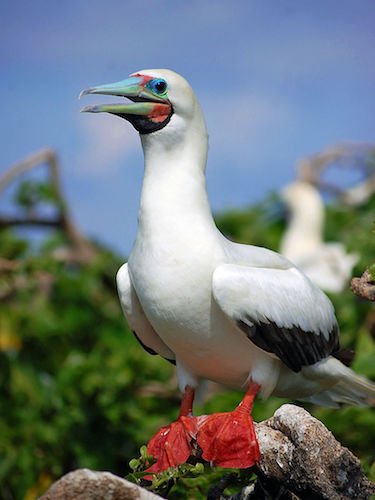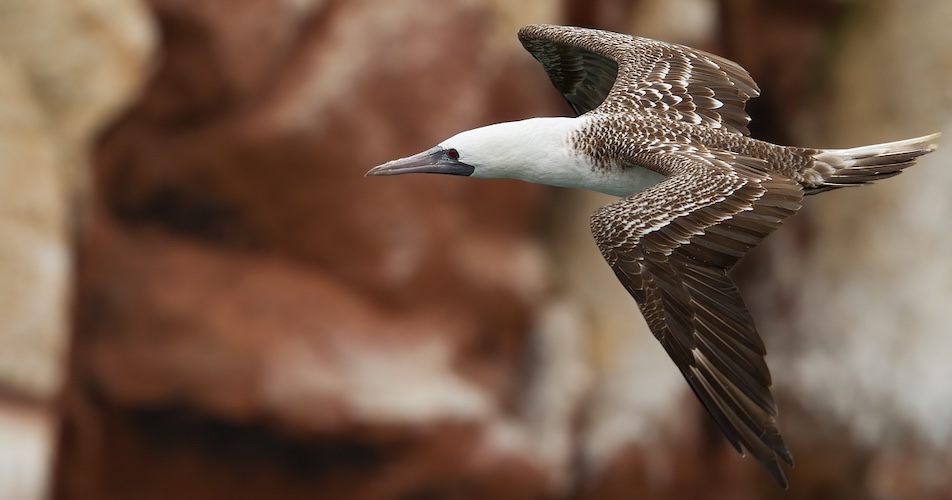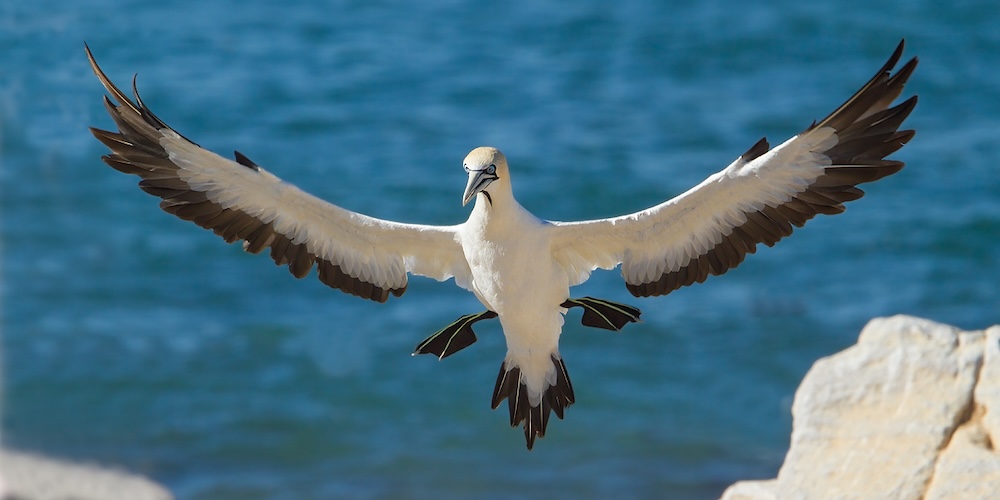Sulidae – Gannets & Boobies

The bird family Sulidae comprises the gannets and boobies. They are Suliformes, as are Fregatidae (Frigatebirds), Anhingidae (Anhingas & Darters) and Phalacrocoracidae (Cormorants & Shags). Collectively called sulids, they are medium to large coastal seabirds that plunge-dive for fish and similar prey. The eleven species in this family are often considered congeneric in older sources, placing all in the genus Sula. However, Sula (true boobies) and Morus (gannets) can be readily distinguished by morphological, behavioural and DNA sequence characters. Papasula (Abbott’s Booby) is given its own genus as it stands apart from both in these respects. It appears to be a distinct and ancient lineage, maybe closer to the gannets than to the true boobies
Sulids measure about 60 to 85 cm in length and have a wingspan of about 140 to 175 cm. They have long, narrow and pointed wings, and a quite long, graduated and rather lozenge-shaped tail whose outer feathers are shorter than the central ones. Their flight muscles are rather small to allow for the small cross section required for plunge-diving, and thus their wing loading is high. Consequently, they are very streamlined, reducing drag, so their bodies are torpedo-shaped, as well as somewhat flat.

Peruvian Booby Sula variegata – ©Dubi Shapiro
They have stout legs and webbed feet, with the web connecting all four toes. In some species the webs are brightly coloured and used in courtship displays. The bill is usually conspicuously coloured, long, deep at the base, and pointed, with saw-like edges. The upper mandible curves down slightly at the tip and can be moved upward to accept large prey. To keep water out during plunges, the nostrils enter into the bill rather than opening to the outside directly. The eyes are angled forward, and provide a wider field of binocular vision than in most other birds.
The plumage is either all-white (or light brownish or greyish) with dark wingtips and (usually) tail, or at least some dark brown or black above with white underparts; gannets have a yellowish hue to the head. The face usually has some sort of black markings, typically on the lores. Unlike their relatives (the darters and cormorants), sulids have a well-developed preen gland whose waxy secretions they spread on their feathers for waterproofing and pest control. They moult their tail feathers irregularly and the flight feathers of their wings in stages, so that starting at the first moult, they always have some old feathers, some new ones, and some partly grown ones. Moult as a response to periods of stress has been recorded.

Cape Gannet Morus capensis – ©Dubi Shapiro
The sulids are distributed mainly in tropical and subtropical waters. However, some, particularly gannets, are found in temperate regions too. These birds are not truly pelagic seabirds like the related Procellariiformes, and usually stay rather close to the coasts. But the abundant colonies of sulids that exist on many Pacific islands suggest that they are not infrequently blown away from their home range by storms, and can wander for long distances in search of a safe place to land if need be.
All species feed entirely at sea, mostly on mid-sized fish and similarly-sized marine invertebrates such as cephalopods. Many species feed communally, and some species follow fishing boats to scavenge discarded by-catch and chum. The typical hunting behaviour is to dive from mid-air, which takes the bird a meter or two under water. If their prey manages to escape the diving birds at first, they may give chase using their legs and wings for underwater swimming.
-
Number of bird species: 11
(As at August 2025)
There are just 11 species in three genera, in the Sulidae family; they are:
Abbott’s Booby Papasula abbotti Ridgway, 1893
Northern Gannet Morus bassanus Linnaeus, 1758
Cape Gannet Morus capensis Lichtenstein, MHK, 1823
Australasian Gannet Morus serrator Gray, GR, 1843
Cocos Booby Sula brewsteri Goss, 1888
Red-footed Booby Sula sula Linnaeus, 1766
Brown Booby Sula leucogaster Boddaert, 1783
Nazca Booby Sula granti Rothschild, 1902
Masked Booby Sula dactylatra Lesson, R, 1831
Peruvian Booby Sula variegata Tschudi, 1843
Blue-footed Booby Sula nebouxii Milne-Edwards, 1882
-
Pelicans, Cormorants and their Relatives - The Pelicaniformes
| By J Bryan Nelson, illustrated by John Busby, Andrew Mackay & Bas Teunis | OUP | 2006 | Hardback | 661 pages, 12 colour plates, 159 b/w illustrations, 62 maps ISBN: 9780198577270 Buy this book from NHBS.com -
Seabirds
| (An Identification Guide) | by Peter Harrison | Christopher Helm | 1991 | Hardback | 448 pages, 324 distribution maps, 88 colour plates, line drawings | ISBN: 9780713635102 Buy this book from NHBS.com -
The Atlantic Gannet
| By Bryan Nelson | Fenix Books | 2001 | Hardback | 396 pages, 8pp colour plates, 100 b/w photos | ISBN: 9780954119102 Buy this book from NHBS.com -
The Gannet
| By Bryan Nelson | T & AD Poyser Ltd (A & C Black) | 2010 | Hardback | 368 pages, photos, illustrations, tables, maps | ISBN: 9781408138588 Buy this book from NHBS.com -
The Sulidae: Gannets and Boobies
| By Bryan Nelson | Scottish Cultural Press | 1978 | Hardback | 1024 pages, 8 colour and 18 black and white plates, 409 text figures | ISBN: 9780197141045 Buy this book from NHBS.com
-
Sulidae
Family AccountSulidae comprises the gannets and boobies. Collectively called sulids, they are medium-large coastal seabirds that plunge-dive for fish and similar prey. -
Sulidae
Family AccountThe Gannets are a small family, comprising two groups of oceanic birds: the gannets themselves which breed in temperate waters...
-
Abbott's Booby Papasula abbotti
Species AccountAbbott's booby (Papasula abbotti) is an endangered seabird of the sulid family, which includes gannets and boobies. It is a large booby, smaller than gannets, and is placed within its own monotypic genus. It was first identified from a specimen collected by William Louis Abbott, who discovered it on Assumption Island in 1892. -
Abbott's Booby Papasula abbotti
Species AccountAbbott's Booby Papasula abbotti has most recently been assessed for The IUCN Red List of Threatened Species in 2019. Papasula abbotti is listed as Endangered under criteria B2ab(ii,iii). -
Abbott's Booby Papasula abbotti
Species AccountSound archive and distribution map. -
Australasian Gannet Morus serrator
Species AccountThe Australasian gannet (Morus serrator or Sula bassana), also known as Australian gannet and Tākapu, is a large seabird of the gannet family Sulidae. -
Australasian Gannet Morus serrator
Species AccountThe male and female Australasian Gannet are similar in plumage. Most of the body is white, with dark tips on the major wing feathers and the inner tail feathers. The head is buff-yellow and the bill pale blue-grey with striking black borders to the bill sheaths. -
Australasian Gannet Morus serrator
Species AccountAustralasian Gannet Morus serrator has most recently been assessed for The IUCN Red List of Threatened Species in 2018. Morus serrator is listed as Least Concern. -
Australasian Gannet Morus serrator
Species AccountSound archive and distribution map. -
Blue-footed Booby Sula nebouxii
Species AccountSound archive and distribution map. -
Blue-footed Booby Sula nebouxii
Species AccountIUCN species profile -
Blue-footed Booby Sula nebouxii
Species AccountThe blue-footed booby (Sula nebouxii) is a marine bird native to subtropical and tropical regions of the Pacific Ocean. It is one of six species of the genus Sula – known as boobies. It is easily recognizable by its distinctive bright blue feet, which is a sexually selected trait. -
Brown Booby Sula leucogaster
Species AccountLarge seabird of inshore and offshore waters in tropical regions of the Atlantic, Indian, and western Pacific Oceans. Head, neck, and upperparts are solidly... -
Brown Booby Sula leucogaster
Species AccountThe brown booby (Sula leucogaster) is a large seabird of the booby family, Sulidae. They present sexual dimorphism. The female booby reaches about 80 centimetres (31 in) in length, its wingspan measures up to 150 cm (4.9 ft), and they can weigh up to 1,300 g (2.9 lb). The male booby reaches about 75 centimetres (30 in) in length, its wingspan measures up to 140 cm (4.6 ft), and they can weigh up to 1,000 g (2.2 lb) -
Brown Booby Sula leucogaster
Species AccountIUCN species status and profile -
Brown Booby Sula leucogaster
Species AccountSound archive and distribution map. -
Cape Gannet Morus capensis
Species AccountThe Cape gannet (Morus capensis) originally Sula capensis, is a large seabird of the gannet family, Sulidae. They are easily identified by their large size, black and white plumage and distinctive yellow crown and hindneck. -
Cape Gannet Morus capensis
Species AccountSpecies account -
Cape Gannet Morus capensis
Species AccountSound archive and distribution map. -
Cocos Booby Sula brewsteri
Species AccountCompare with other boobies. Often seen from beaches, sometimes just beyond the breakers. Usually plunge-dives from a shallow angle, much closer to the water... -
Cocos Booby Sula brewsteri
Species AccountThe brown booby is a large seabird of the booby family, Sulidae, of which it is perhaps the most common and widespread species. It has a pantropical range, which overlaps with that of other booby species. -
Masked Booby Sula dactylatra
Species AccountThe masked booby (Sula dactylatra) is a large seabird of the booby family, Sulidae. This species breeds on islands in tropical oceans, except in the eastern Atlantic; in the eastern Pacific it is replaced by the Nazca booby, Sula granti, which was formerly regarded as a subspecies of masked booby.[2][3] It is also called the masked gannet or the blue-faced booby. -
Masked Booby Sula dactylatra
Species AccountA large seabird of tropical oceans, the Masked Booby is only a rare visitor to North America. -
Masked Booby Sula dactylatra
Species AccountIUCN species profile -
Masked Booby Sula dactylatra
Species AccountSound archive and distribution map. -
Nazca Booby Sula granti
Species AccountThe Nazca booby (Sula granti) is a colonial seabird in the family Sulidae, native to the eastern Pacific. -
Nazca Booby Sula granti
Species AccountSpecies account -
Nazca Booby Sula granti
Species AccountSound archive and distribution map. -
Northern Gannet Sula bassanus
Species AccountSound archive and distribution map. -
Northern Gannet Sula bassanus
Species AccountNorthern Gannet Morus bassanus has most recently been assessed for The IUCN Red List of Threatened Species in 2018. Morus bassanus is listed as Least Concern. -
Northern Gannet Sula bassanus
Species AccountThe northern gannet (Morus bassanus) is a seabird and the largest member of the gannet family, Sulidae. "Gannet" is derived from Old English ganot "strong or masculine", ultimately from the same Old Germanic root as "gander".[2] Morus is derived from Ancient Greek moros, "foolish" due to the lack of fear shown by breeding gannets and boobies allowing them to be easily killed. The specific bassanus is from the Bass Rock in the Firth of Forth, which holds the world's largest colony of northern gannets.[3] -
Peruvian Booby Sula variegata
Species AccountPeruvian Booby Sula variegata Also seen perched on jetties and cliffs; often with cormorants and pelicans. Adult is distinctive with a snow-white head and neck... -
Peruvian Booby Sula variegata
Species AccountThe Peruvian booby (Sula variegata) is an endemic bird of the Peruvian current, and an important predator of the marine community to which it belongs.[2] Its distribution is much less widespread than other closely related booby species. It is the most abundant seabird species that inhabits the Peruvian coast[3] and the second most important guano-producing seabird. During the mid-twentieth century, the Peruvian booby population reached 3 million birds. -
Peruvian Booby Sula variegata
Species AccountIUCN species profile -
Peruvian Booby Sula variegata
Species AccountSound archive and distribution map. -
Red-footed Booby Sula sula
Species AccountLarge seabird of offshore tropical waters around the globe; not seen from the mainland. Adult plumage is variable, but all have bright red feet and colorful... -
Red-footed Booby Sula sula
Species AccountThe red-footed booby (Sula sula) is a large seabird of the booby family, Sulidae. As suggested by the name, adults always have red feet, but the colour of the plumage varies. They are powerful and agile fliers, but they are clumsy in takeoffs and landings. They are found widely in the tropics, and breed colonially in coastal regions, especially islands. -
Red-footed Booby Sula sula
Species AccountRed-footed Booby Sula sula has most recently been assessed for The IUCN Red List of Threatened Species in 2020. Sula sula is listed as Least Concern. -
Red-footed Booby Sula sula
Species AccountSound archive and distribution map.
